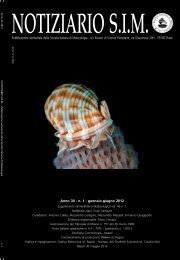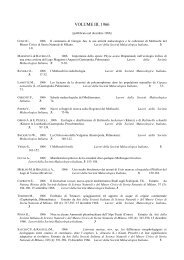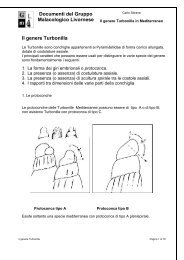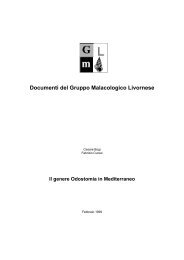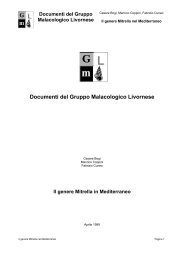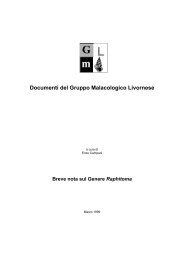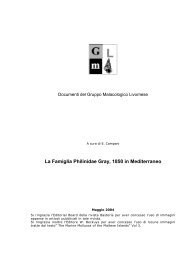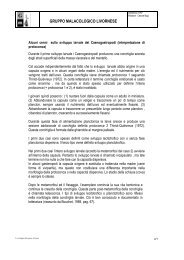scarica il Notiziario S.I.M. - Società Italiana di Malacologia
scarica il Notiziario S.I.M. - Società Italiana di Malacologia
scarica il Notiziario S.I.M. - Società Italiana di Malacologia
You also want an ePaper? Increase the reach of your titles
YUMPU automatically turns print PDFs into web optimized ePapers that Google loves.
Contributi 34<br />
<strong>Notiziario</strong> S.I.M. 23 (9-12) pp. 34-36 sett.-<strong>di</strong>c. 2005 <strong>di</strong>cembre 2005<br />
Occurrence of the Western Atlantic Cerithium litteratum<br />
(Born, 1778) (Gastropoda: Cerithiidae) in The Aegean Sea<br />
Vittorio Gar<strong>il</strong>li* & Evi Vardala Theodorou**<br />
Key Words: Cerithium litteratum, Exotic species, Aegean Sea,<br />
Greece.<br />
Introduction<br />
The gastropod genus Cerithium Bruguière, 1789 is well<br />
represented in subtropical and tropical shallow marine<br />
environments of the world by several highly polymorphic<br />
species (Houbrick, 1974, 1992). Accor<strong>di</strong>ng to the<br />
reasonable view of Boisselier-Dubayle & Gofas (1999),<br />
at least four species are endemic to the Me<strong>di</strong>terranean<br />
Sea: Cerithium vulgatum Bruguière, 1792 and Cerithium<br />
“lagoon” (closely related to C. vulgatum), in the group<br />
of the larger morphs, and C. lividulum Risso, 1826 and<br />
C. “rupestre” (correctly named as C. renovatum Monterosato,<br />
1884 by Gofas et al., 2003) within the group of the<br />
smaller morphs generally confused under the name<br />
Cerithium rupestre Risso, 1826. With regard to the exotic<br />
mollusc assemblage in the Me<strong>di</strong>terranean, five to six cerithiids,<br />
all Lessepsian species, introduced in the Me<strong>di</strong>terranean<br />
via the Suez Canal, are recorded (Giannuzzi<br />
Savelli et al., 1996; Zenetos et al., 2003): Cerithium egenum<br />
Gould, 1849, C. nesioticum P<strong>il</strong>sbry & Vanatta, 1906, C.<br />
scabridum Ph<strong>il</strong>ippi, 1848, Clypeomorus bifasciutus (Sowerby<br />
G.B. II, 1855) and Rhinoclavis kochi (Ph<strong>il</strong>ippi, 1848).<br />
The aim of this note is to record the occurrence in the<br />
Me<strong>di</strong>terranean Sea of the Western Atlantic species<br />
Cerithium litteratum (Born, 1778).<br />
Material<br />
Our record is based on one shell (Fig. 1), collected in<br />
Saronikos Gulf, in 1978 and housed in the collection of<br />
the Molluscs from the Greek seas in the Goulandris<br />
Natural History Museum, under the number ID 55/21.<br />
The shell was among other molluscs with hermit crabs<br />
in a material from fisherman nets. It is 15.1 mm in<br />
height and has a conical-turreted shape. Sculpture<br />
mainly consists of two spiralling series of prominent<br />
knobs. These are present at the base and in sub-sutural<br />
position where they are particularly marked and almost<br />
spiny. Secondary irregular spiral cords, sometime crenulated,<br />
occur. Aperture is wide and ovate, with a projecting<br />
forward outer lip. Anterior canal is short and<br />
Introduzione<br />
Il genere Cerithium Bruguière, 1789 è rappresentato da<br />
taxa, caratterizzati da un elevato polimorfismo, viventi<br />
nelle acque basse delle regioni tropicali e subtropicali <strong>di</strong><br />
tutto <strong>il</strong> mondo (Houbrick, 1974, 1992). Secondo la ragionevole<br />
visione sistematica <strong>di</strong> Boisselier-Dubayle &<br />
Gofas (1999), almeno quattro specie endemiche abitano<br />
le acque me<strong>di</strong>terranee: Cerithium vulgatum Bruguière,<br />
1792 e Cerithium “lagoon” (morfologicamente assai<br />
prossimo a C. vulgatum), relativamente al gruppo dei<br />
morfotipi caratterizzati da una grande conchiglia, e C.<br />
lividulum Risso, 1826 e C. “rupestre” (<strong>il</strong> cui nome corretto<br />
è C. renovatum Monterosato, 1884, Gofas et al., 2003),<br />
nell’ambito dei piccoli morfotipi, generalmente confusi<br />
sotto <strong>il</strong> nome <strong>di</strong> Cerithium rupestre Risso, 1826. Con riguardo<br />
al contingente <strong>di</strong> specie esotiche, presenti in<br />
Me<strong>di</strong>terraneo, 5-6 cerizii sono segnalati come forme lessepsiane,<br />
introdotte in Me<strong>di</strong>terraneo attraverso <strong>il</strong><br />
Canale <strong>di</strong> Suez (Giannuzzi Savelli et al., 1996; Zenetos et<br />
al., 2003): Cerithium egenum Gould, 1849, C. nesioticum<br />
P<strong>il</strong>sbry & Vanatta, 1906, C. scabridum Ph<strong>il</strong>ippi, 1848, Clypeomorus<br />
bifasciutus (Sowerby G.B. II, 1855) e Rhinoclavis<br />
kochi (Ph<strong>il</strong>ippi, 1848).<br />
Lo scopo <strong>di</strong> questa nota è <strong>di</strong> segnalare la presenza <strong>di</strong><br />
Cerithium litteratum (Born, 1778), specie vivente in<br />
Atlantico occidentale, nelle acque me<strong>di</strong>terranee.<br />
Materiale<br />
’<br />
Contributi<br />
La segnalazione è basata su una conchiglia (Fig. 1) proveniente<br />
dal Golfo Saronico e custo<strong>di</strong>ta nella collezione<br />
dei Molluschi dei Mari Greci, presso <strong>il</strong> Museo <strong>di</strong> Storia<br />
Naturale Goulandris (numero <strong>di</strong> catalogo ID 55/21). La<br />
conchiglia faceva parte <strong>di</strong> un lotto contenente nicchi pagurati,<br />
raccolti dalle reti <strong>di</strong> pesca nel 1978. Essa presenta<br />
un’altezza <strong>di</strong> 15.1 mm ed un aspetto conico-turricolato.<br />
L’ornamentazione consiste <strong>di</strong> due serie spirali <strong>di</strong> tubercoli<br />
piuttosto prominenti, presenti alla base ed in posizione<br />
sottosuturale. I tubercoli sottosuturali sono particolarmente<br />
pronunciati, quasi spinosi. Sono inoltre presenti,<br />
seppur irregolarmente, cordoni spirali secondari,<br />
talora crenulati. L’apertura è ampia ed ovata; <strong>il</strong> labbro<br />
* Dipartimento <strong>di</strong> Geologia e Geodesia, Università <strong>di</strong> Palermo, Corso Tuköry, 131, 90134 - Palermo, Italy, nenti@tiscali.it.<br />
** Goulandris Natural History Museum - GAIA Centre, 100, Othonos St., 14562 - Kifissia, Greece.



